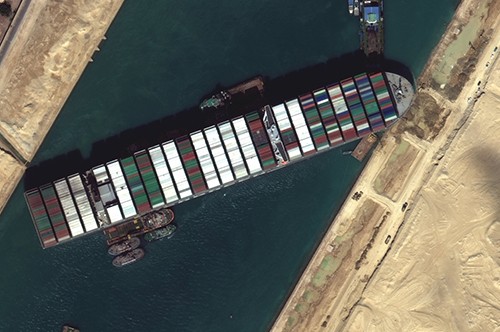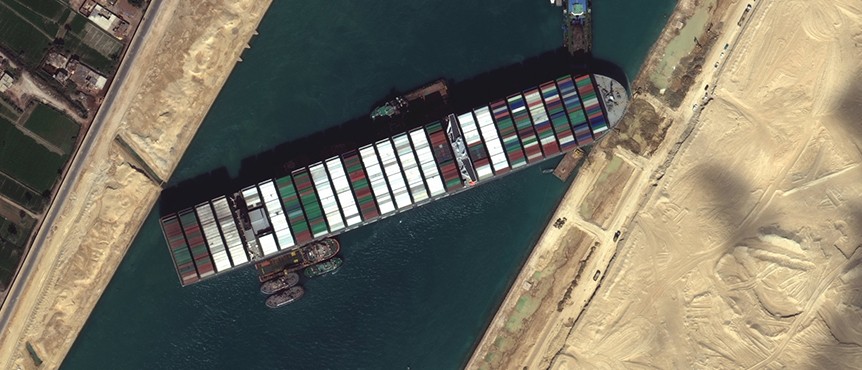How logistics specialists are dealing with global supply chain disruptions that have no near-term solution.


In March 2021, the Suez Canal in Egypt was blocked for six days after a 20,000 TEU container ship, Ever Given, grounded laterally, preventing an estimated US$9.6 billion worth of trade. The incident is symbolic in a year where global logistics challenges, which many expected to subside after the initial impact of the pandemic, have become even more pronounced. A lack of warehousing availability, sky-rocketing container rates, port congestion and trucker shortages are the symptoms of a globalized industry struggling to come to terms with the dichotomy of rising demand and Covid restrictions.
A series of events in the Americas, from climate-related issues such as the February freeze in the US, to sociopolitical disruptions such as protestors blocking the Port of Buenaventura in Colombia in May, have impacted trade routes throughout Latam. While these disturbances have exacerbated the situation, unbalanced supply and demand has been the fundamental cause of logistics delays and rising freight costs. “On the supply side, the industry has not invested significantly into expanding capacity, and this is many times the case when you have an economy which is not performing well,” explained Robbert van Trooijen, senior vice president – head of Latin America for A.P. Moller – Maersk.
The initial outbreak of Covid-19 caused Chinese factory closures in early 2020, and this was followed by an implosion of demand as the pandemic became global. When a level of normalization was re-established, demand grew faster than usual, including the chemicals industry, and this has continued well into 2021. “We are currently in a situation where there are not enough shipping vessels to meet demand, the global shipping fleet is fully deployed, and new builds are only going to come out of the yards in late 2022 or early 2023,” observed van Trooijen, who added that, while rates have become extortionate, clients on long-term contracts are offered more stable rates.

“In light of the pandemic, many companies have been facing challenges with the inter-Latam supply chains, mainly due to constraints on capacity and container availability for ocean shipments. This reality drove companies to look for land transportation alternatives to ship their goods around the continent.”
Helio Coelho, Global Chemical Sales Director – Latin America, BDP International
Peter Staartjes, CEO of Andino / Andikem, revealed that container rates from Asia to Latin America have gone from US$3,000 to over US$15,000, or even US$20,000 in some cases. In spite of the challenges, the company’s revenues forecasted for 2021 will be double those of 2019, according to Staartjes, with most of the increases coming from volume and services. As record profits are reported across the industry, how are logistics providers taking advantage of the favorable business climate and reinvesting to mitigate logistics challenges?
In the case of Andikem, the company has added more capabilities to support its operations, including acquiring a second ship (M/T Andino Nu) which will support its M/T Andino Alpha ship (both are ~14,000-deadweight stainless steel tankers with multiple segregations). “We noticed early on this year that many suppliers wanted to switch to bulk because they could no longer satisfy their customers with flexi-tanks and ISO-tainers the way they were in the past,” explained Staartjes, suggesting this will lead to a modality shift for which suppliers and end users flexible enough to switch to bulk from containers via the hub and spoke model will gain market share over those who cannot.
“Increased logistics and freight costs is an issue for the entire market and there is currently no ideal short-term solution,” reflected Martin Sack, Leschaco’s regional head for the Americas. Sack also commented that infrastructural and political issues in Latam, such as social unrest in Colombia and Chile, and a rail blockade in Mexico, have significantly impacted the flow of goods in the region.
To adapt to the new normal, Leschaco has ramped up digital capabilities and decreased bottlenecks, increasing connectivity between its systems and customers to improve end-to-end visibility. “There is no doubt that the pandemic and global trade disruption has accelerated the need for and adoption of technologies,” remarked Sack, adding: “Digitization was a trend before the pandemic but has now become a necessity.”
Helio Coelho, BDP International’s global chemical sales director, remarked that while ocean transportation is critical, companies have started to look for alternatives such as road or air transportation to try and meet demands. Looking for alternative solutions has also been necessary to navigate the volatile sociopolitical climate in Latin America, and Coelho gave the example of how BDP International reacted to blockades caused by protestors at the Port of Buenaventura: “We quickly collaborated with customers to implement and execute out of the box ideas such as cabotage transportation and usage of our free trade zones services in Cartagena, to ensure business continuity and minimize the impacts of the disruption.”
Tank container demand outstrips availability
To illustrate the extent to which container rates have risen in 2021, Rodrigo Gutierrez, CEO of chemical distributor GTM Holdings, revealed that at times containers have cost more than the product being delivered. Due to the capex-intensity and time required to increase the global fleet of tanks and ships, this is not a situation which can be resolved overnight. “The manufacturing of containers is globally concentrated amongst approximately four companies, which can not necessarily rapidly increase production capacity,” added Gutierrez.
Until new equipment comes into the market, the companies that offer equipment for the transport and storage of tanks, otherwise known as tank container operators (TCO), are having to be creative. Fabiano Machion, Newport Tank’s general manager for South America, suggested that technology can help streamline logistics chains. “For the next two years we will be investing heavily in digitalization and information security systems in order to deliver better logistical tools to our end users based on algorithms and intelligent systems,” stated Machion, adding: “Digitalization will lead to more services, agility and intelligence to have more logistical savings and an influx of shipments.”

“The availability and cost of containers has been a significant issue. To illustrate how challenging this situation has become, there were times where we had to pay US$12,000 to rent a container, making the container cost more than the product being delivered.”
Rodrigo Gutierrez, CEO, GTM Holdings
While discussing the ISO tank leasing model, Christopher Sandler, managing director of Eurotainer, mentioned a benefit which sometimes gets lost in purchasing and is particularly relevant in the current global context where supply chain disruptions have caused delays – the demurrage charges in normal operations. “Demurrage is billed per container and per day by truck operators and tank operators with the charged amount varying per location and equipment type. Having a leased tank container, paying a fixed fee regardless of how long the tank is delayed at a location, can significantly decrease these charges.”
One of the main reasons that demand for bulk liquid storage in Latin America has increased in recent years is the availability of a variety of petrochemicals and biofuels products coming from the Gulf of Mexico in the USA, according to Giancarlo Facchini, Oiltanking’s commercial manager for Colombia and Panama. “In addition, we have seen an increase in the demand for storage for marine fuels due to the new regulations demanded by IMO 2020 for our terminal located on the Atlantic side of the Panama channel,” said Facchini, suggesting that in the future, bulk liquid storage will evolve to the storage of cleaner products that will help reduce emissions such as LNG, LPG and hydrogen.

In March 2021, the Suez Canal in Egypt was blocked for six days after a 20,000 TEU container ship, Ever Given, grounded laterally, preventing an estimated US$9.6 billion worth of trade. The incident is symbolic in a year where global logistics challenges, which many expected to subside after the initial impact of the pandemic, have become even more pronounced. A lack of warehousing availability, sky-rocketing container rates, port congestion and trucker shortages are the symptoms of a globalized industry struggling to come to terms with the dichotomy of rising demand and Covid restrictions.
A series of events in the Americas, from climate-related issues such as the February freeze in the US, to sociopolitical disruptions such as protestors blocking the Port of Buenaventura in Colombia in May, have impacted trade routes throughout Latam. While these disturbances have exacerbated the situation, unbalanced supply and demand has been the fundamental cause of logistics delays and rising freight costs. “On the supply side, the industry has not invested significantly into expanding capacity, and this is many times the case when you have an economy which is not performing well,” explained Robbert van Trooijen, senior vice president – head of Latin America for A.P. Moller – Maersk.
The initial outbreak of Covid-19 caused Chinese factory closures in early 2020, and this was followed by an implosion of demand as the pandemic became global. When a level of normalization was re-established, demand grew faster than usual, including the chemicals industry, and this has continued well into 2021. “We are currently in a situation where there are not enough shipping vessels to meet demand, the global shipping fleet is fully deployed, and new builds are only going to come out of the yards in late 2022 or early 2023,” observed van Trooijen, who added that, while rates have become extortionate, clients on long-term contracts are offered more stable rates.

“In light of the pandemic, many companies have been facing challenges with the inter-Latam supply chains, mainly due to constraints on capacity and container availability for ocean shipments. This reality drove companies to look for land transportation alternatives to ship their goods around the continent.”
Helio Coelho, Global Chemical Sales Director – Latin America, BDP International
Peter Staartjes, CEO of Andino / Andikem, revealed that container rates from Asia to Latin America have gone from US$3,000 to over US$15,000, or even US$20,000 in some cases. In spite of the challenges, the company’s revenues forecasted for 2021 will be double those of 2019, according to Staartjes, with most of the increases coming from volume and services. As record profits are reported across the industry, how are logistics providers taking advantage of the favorable business climate and reinvesting to mitigate logistics challenges?
In the case of Andikem, the company has added more capabilities to support its operations, including acquiring a second ship (M/T Andino Nu) which will support its M/T Andino Alpha ship (both are ~14,000-deadweight stainless steel tankers with multiple segregations). “We noticed early on this year that many suppliers wanted to switch to bulk because they could no longer satisfy their customers with flexi-tanks and ISO-tainers the way they were in the past,” explained Staartjes, suggesting this will lead to a modality shift for which suppliers and end users flexible enough to switch to bulk from containers via the hub and spoke model will gain market share over those who cannot.
“Increased logistics and freight costs is an issue for the entire market and there is currently no ideal short-term solution,” reflected Martin Sack, Leschaco’s regional head for the Americas. Sack also commented that infrastructural and political issues in Latam, such as social unrest in Colombia and Chile, and a rail blockade in Mexico, have significantly impacted the flow of goods in the region.
To adapt to the new normal, Leschaco has ramped up digital capabilities and decreased bottlenecks, increasing connectivity between its systems and customers to improve end-to-end visibility. “There is no doubt that the pandemic and global trade disruption has accelerated the need for and adoption of technologies,” remarked Sack, adding: “Digitization was a trend before the pandemic but has now become a necessity.”
Helio Coelho, BDP International’s global chemical sales director, remarked that while ocean transportation is critical, companies have started to look for alternatives such as road or air transportation to try and meet demands. Looking for alternative solutions has also been necessary to navigate the volatile sociopolitical climate in Latin America, and Coelho gave the example of how BDP International reacted to blockades caused by protestors at the Port of Buenaventura: “We quickly collaborated with customers to implement and execute out of the box ideas such as cabotage transportation and usage of our free trade zones services in Cartagena, to ensure business continuity and minimize the impacts of the disruption.”
Tank container demand outstrips availability
To illustrate the extent to which container rates have risen in 2021, Rodrigo Gutierrez, CEO of chemical distributor GTM Holdings, revealed that at times containers have cost more than the product being delivered. Due to the capex-intensity and time required to increase the global fleet of tanks and ships, this is not a situation which can be resolved overnight. “The manufacturing of containers is globally concentrated amongst approximately four companies, which can not necessarily rapidly increase production capacity,” added Gutierrez.
Until new equipment comes into the market, the companies that offer equipment for the transport and storage of tanks, otherwise known as tank container operators (TCO), are having to be creative. Fabiano Machion, Newport Tank’s general manager for South America, suggested that technology can help streamline logistics chains. “For the next two years we will be investing heavily in digitalization and information security systems in order to deliver better logistical tools to our end users based on algorithms and intelligent systems,” stated Machion, adding: “Digitalization will lead to more services, agility and intelligence to have more logistical savings and an influx of shipments.”

“The availability and cost of containers has been a significant issue. To illustrate how challenging this situation has become, there were times where we had to pay US$12,000 to rent a container, making the container cost more than the product being delivered.”
Rodrigo Gutierrez, CEO, GTM Holdings
While discussing the ISO tank leasing model, Christopher Sandler, managing director of Eurotainer, mentioned a benefit which sometimes gets lost in purchasing and is particularly relevant in the current global context where supply chain disruptions have caused delays – the demurrage charges in normal operations. “Demurrage is billed per container and per day by truck operators and tank operators with the charged amount varying per location and equipment type. Having a leased tank container, paying a fixed fee regardless of how long the tank is delayed at a location, can significantly decrease these charges.”
One of the main reasons that demand for bulk liquid storage in Latin America has increased in recent years is the availability of a variety of petrochemicals and biofuels products coming from the Gulf of Mexico in the USA, according to Giancarlo Facchini, Oiltanking’s commercial manager for Colombia and Panama. “In addition, we have seen an increase in the demand for storage for marine fuels due to the new regulations demanded by IMO 2020 for our terminal located on the Atlantic side of the Panama channel,” said Facchini, suggesting that in the future, bulk liquid storage will evolve to the storage of cleaner products that will help reduce emissions such as LNG, LPG and hydrogen.